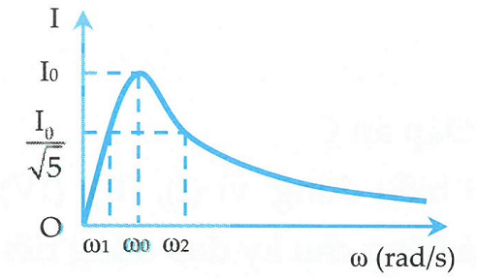Câu hỏi: Cho đoạn mạch điện xoay chiều gồm điện trở thuần, cuộn cảm thuần L và tụ điện C mắc nối tiếp. Đặt vào hai đầu đoạn mạch một điện áp xoay chiều $\text{u = }{{\text{U}}_{\text{0}}}\text{cos }\!\!\omega\!\!\text{ t}\left( \text{V} \right),\!\!\omega\!\!$ có thể thay đổi được. Đồ thị sự phụ thuộc của cường độ dòng điện hiệu dụng vào co như hình vẽ. Trong đó ${{\!\!\omega\!\!}_{2}}-{{\!\!\omega\!\!}_{\text{1}}}=\dfrac{\text{400}}{\!\!\pi\!\!}\left( \text{rad/s} \right),\text{L=}\dfrac{\text{3 }\!\!\pi\!\!}{\text{4}}\text{H}$. Điện trở R có giá trị là:
A. $\text{150}\Omega $
B. $\text{160}\Omega $
C. $75\sqrt{2}\Omega $
D. $\text{100}\Omega $
 Ta nhận thấy đồ thị trên thể hiện sự phụ thuộc của cường độ dòng điện I khi thay đổi tần số gốc
Ta nhận thấy đồ thị trên thể hiện sự phụ thuộc của cường độ dòng điện I khi thay đổi tần số gốc
Cường độ dòng điện được tính theo biểu thức: $\text{I}=\dfrac{\text{U}}{\text{Z}}=\dfrac{\text{U}}{\sqrt{{{\text{R}}^{\text{2}}}+{{\left( {{\text{Z}}_{\text{L}}}-{{\text{Z}}_{\text{C}}} \right)}^{2}}}}$
Nên ${{\text{I}}_{\text{max}}}\text{= }\dfrac{\text{U}}{\text{R}}$ khi $\!\!\omega\!\!\text{ = }{{\!\!\omega\!\!}_{0}}$
Đối với $\!\!\omega\!\!\text{ = }{{\!\!\omega\!\!}_{1}}\text{; }\!\!\omega\!\!\text{ = }{{\!\!\omega\!\!}_{2}}$ thì ${{\text{I}}_{\text{1 }}}\text{= }{{\text{I}}_{\text{2 }}}\text{= }\dfrac{\text{I}}{\sqrt{\text{5}}}$
$\Rightarrow \dfrac{\text{U}}{\sqrt{{{\text{R}}^{\text{2}}}+{{\left( {{\text{Z}}_{\text{L1}}}-{{\text{Z}}_{\text{C}1}} \right)}^{2}}}}=\dfrac{\text{U}}{\sqrt{{{\text{R}}^{\text{2}}}+{{\left( {{\text{Z}}_{\text{L2}}}-{{\text{Z}}_{\text{C2}}} \right)}^{2}}}}=\dfrac{\text{U}}{\sqrt{\text{5}}\text{R}}$
Khi ${{\!\!\omega\!\!}_{2}}\text{}{{\!\!\omega\!\!}_{1}}$ thì ${{\text{Z}}_{\text{L2 }}}{{\text{Z}}_{\text{L1}}}\text{; }{{\text{Z}}_{\text{C2}}}\text{ }{{\text{Z}}_{\text{C1}}}$ nên
$\left\{ \begin{aligned}
& {{\text{Z}}_{\text{L1}}}-{{\text{Z}}_{\text{C1}}}=-\text{2R} \\
& {{\text{Z}}_{\text{L2}}}-{{\text{Z}}_{\text{C2}}}=\text{2R} \\
\end{aligned} \right.\Rightarrow \left\{ \begin{aligned}
& {{\!\!\omega\!\!}_{\text{1}}}\text{L}-\dfrac{\text{1}}{{{\!\!\omega\!\!}_{\text{1}}}\text{L}}=-2\text{R} \\
& {{\!\!\omega\!\!}_{\text{2}}}\text{L}-\dfrac{1}{{{\!\!\omega\!\!}_{2}}\text{L}}=2\text{R} \\
\end{aligned} \right.\Rightarrow \left\{ \begin{aligned}
& \!\!\omega\!\!_{\text{1}}^{\text{2}}\text{LC}-1=-\text{2RC}{{\!\!\omega\!\!}_{\text{1}}} \\
& \!\!\omega\!\!_{\text{2}}^{\text{2}}\text{LC}-1=2\text{RC}{{\!\!\omega\!\!}_{\text{2}}} \\
\end{aligned} \right.$
Nên ta có $\!\!\omega\!\!_{\text{2}}^{\text{2}}\text{LC}-\!\!\omega\!\!_{\text{1}}^{\text{2}}\text{LC}=2\text{RC}\left( {{\omega }_{2}}+{{\omega }_{1}} \right)$ $\Rightarrow \text{R}=\dfrac{\text{L}\left( {{\!\!\omega\!\!}_{\text{2}}}-{{\!\!\omega\!\!}_{1}} \right)}{2}=150\Omega $
A. $\text{150}\Omega $
B. $\text{160}\Omega $
C. $75\sqrt{2}\Omega $
D. $\text{100}\Omega $
Cường độ dòng điện được tính theo biểu thức: $\text{I}=\dfrac{\text{U}}{\text{Z}}=\dfrac{\text{U}}{\sqrt{{{\text{R}}^{\text{2}}}+{{\left( {{\text{Z}}_{\text{L}}}-{{\text{Z}}_{\text{C}}} \right)}^{2}}}}$
Nên ${{\text{I}}_{\text{max}}}\text{= }\dfrac{\text{U}}{\text{R}}$ khi $\!\!\omega\!\!\text{ = }{{\!\!\omega\!\!}_{0}}$
Đối với $\!\!\omega\!\!\text{ = }{{\!\!\omega\!\!}_{1}}\text{; }\!\!\omega\!\!\text{ = }{{\!\!\omega\!\!}_{2}}$ thì ${{\text{I}}_{\text{1 }}}\text{= }{{\text{I}}_{\text{2 }}}\text{= }\dfrac{\text{I}}{\sqrt{\text{5}}}$
$\Rightarrow \dfrac{\text{U}}{\sqrt{{{\text{R}}^{\text{2}}}+{{\left( {{\text{Z}}_{\text{L1}}}-{{\text{Z}}_{\text{C}1}} \right)}^{2}}}}=\dfrac{\text{U}}{\sqrt{{{\text{R}}^{\text{2}}}+{{\left( {{\text{Z}}_{\text{L2}}}-{{\text{Z}}_{\text{C2}}} \right)}^{2}}}}=\dfrac{\text{U}}{\sqrt{\text{5}}\text{R}}$
Khi ${{\!\!\omega\!\!}_{2}}\text{}{{\!\!\omega\!\!}_{1}}$ thì ${{\text{Z}}_{\text{L2 }}}{{\text{Z}}_{\text{L1}}}\text{; }{{\text{Z}}_{\text{C2}}}\text{ }{{\text{Z}}_{\text{C1}}}$ nên
$\left\{ \begin{aligned}
& {{\text{Z}}_{\text{L1}}}-{{\text{Z}}_{\text{C1}}}=-\text{2R} \\
& {{\text{Z}}_{\text{L2}}}-{{\text{Z}}_{\text{C2}}}=\text{2R} \\
\end{aligned} \right.\Rightarrow \left\{ \begin{aligned}
& {{\!\!\omega\!\!}_{\text{1}}}\text{L}-\dfrac{\text{1}}{{{\!\!\omega\!\!}_{\text{1}}}\text{L}}=-2\text{R} \\
& {{\!\!\omega\!\!}_{\text{2}}}\text{L}-\dfrac{1}{{{\!\!\omega\!\!}_{2}}\text{L}}=2\text{R} \\
\end{aligned} \right.\Rightarrow \left\{ \begin{aligned}
& \!\!\omega\!\!_{\text{1}}^{\text{2}}\text{LC}-1=-\text{2RC}{{\!\!\omega\!\!}_{\text{1}}} \\
& \!\!\omega\!\!_{\text{2}}^{\text{2}}\text{LC}-1=2\text{RC}{{\!\!\omega\!\!}_{\text{2}}} \\
\end{aligned} \right.$
Nên ta có $\!\!\omega\!\!_{\text{2}}^{\text{2}}\text{LC}-\!\!\omega\!\!_{\text{1}}^{\text{2}}\text{LC}=2\text{RC}\left( {{\omega }_{2}}+{{\omega }_{1}} \right)$ $\Rightarrow \text{R}=\dfrac{\text{L}\left( {{\!\!\omega\!\!}_{\text{2}}}-{{\!\!\omega\!\!}_{1}} \right)}{2}=150\Omega $
Đáp án A.
